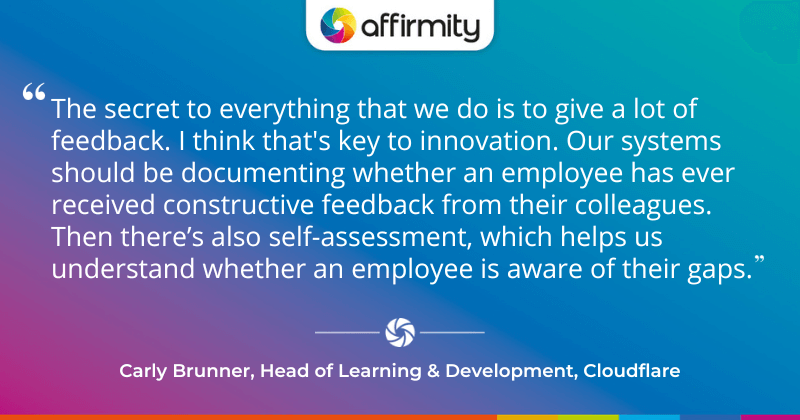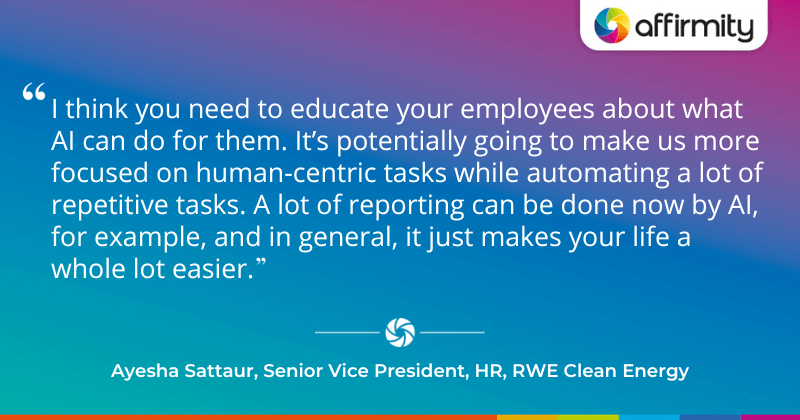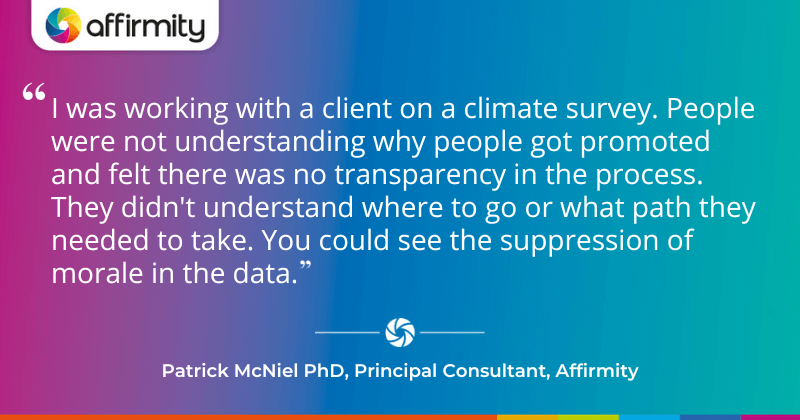The Affirmity team recently attended the From Day One (FD1) conference in Austin, Texas, and our own Principal Consultant, Patrick McNiel PhD, participated in a lively panel discussion on “Inclusive Career Growth: Using Data and Innovation to Empower Today’s Workforce”. In this article, we’ve summarized the key takeaways from the wide-ranging session, which covers adopting people-first strategies, embracing new tools and models of growth, and providing inclusive opportunities for career advancement.
1) Empowerment Through Culture and Tools
When you think of innovative contemporary approaches to modern work, the sprawling campuses, unusual perks, and experimental organizational structures of the Silicon Valley tech giants come to mind. Appropriately, a representative from one of the biggest—Joe Davis, Head of Innovation, Dev Platforms & Learning Ecosystem for Google.org—was on hand to provide insight into his own experience of how the internet leader approaches career growth.
“We have things called 20% projects, where you can spend 20% of your time on something completely outside of your scope or role. That’s just one policy the culture has adopted that allowed me to get very different skills. I went from an operations role in a policies department to suddenly becoming a marketing manager overseeing three people and a whole global product. Now I’m in a corporate philanthropy arm.”
As Davis explains, establishing these kinds of cultural norms can cultivate curiosity and skill-building well beyond an employee’s initial role:
“I’m finding after 11 years, I’ve got such a wide set of skills: some of it I intentionally grew, some of it was just saying ‘yes, let’s figure this out!’ I feel it’s rounded out my experience. It can be controlled, but it’s also a bit more organic. And leaning into that is an important development philosophy in our new hire orientation and all of our manager trainings.”
Staying within tech, Carly Brunner, Head of Learning & Development at Cloudflare, highlighted her organization’s “employee-driven, manager-facilitated, and Cloudflare–enabled” approach:
“We say this a lot to all of our new hires: like the New York City subway, ‘if you see something, say something.’ We find that those who are the most successful at Cloudflare are those who see something wrong, and it doesn’t matter if it’s within their role or not, they’re going to step in and help. We really promote that at the beginning.”
2) Career Growth Must Be Intentional and Transparent
The panel then explored how companies should make more of an effort to outline how employees can advance—and how they should go about providing that transparency. Ayesha Sattaur of RWE Clean Energy talked of her organization’s own experiences with creating clear career pathing. She emphasized how the clarity it created was beneficial for new joinees and existing employees alike.
In particular, Sattaur discussed creating defined expert tracks—for example, for people leaders—built with knowledge of the necessary skills and competencies. She also described the organization’s cross-department approach:
“If they’re in one department, they may see that a career path ends at a certain point, and then may decide that they want to go to a different department. They can go on to our SharePoint and look up all of those competencies and be able to say, ‘okay I know what it takes to work in finance, or work in this position.’”
At this point, Affirmity’s own Patrick McNiel shared a relevant case study, in which a lack of transparency around promotions had resulted in low employee morale.
“I was working with a client on a climate survey. In conjunction with low scores on trust in leadership and operational fairness, we had a bunch of comments. All these comments were about people getting promoted who didn’t deserve the promotion. People were also not understanding why those people got promoted and felt there was no transparency in the process. They didn’t understand where to go or what path they needed to take. You could see the suppression of morale in the data—there was also an in-group/out-group situation where some people were getting everything and other people were getting nothing.”
Patrick then explained how, after implementing clearer processes, the organization saw a significant improvement in climate survey scores.
“They focused very intensely on this for about two years to fix it and resurveyed. Their entire set of climate scores went up by a pretty significant margin. Little things like that can have a huge impact on an organization’s morale.”
WHY WORKFORCE DATA REMAINS KEY | ‘Life After EO 11246: Why and Where Workforce Demographic Data Is Still Required’
3) Psychological Safety and Feedback Loops
The conversation then turned to the importance of ensuring psychological safety in the workplace, with Dr. James Billings, Vice Provost of Academic Affairs at National University, describing what’s required:
“It’s not always an easy thing to accomplish. It does take very intentional efforts. There has to be that culture where employees feel safe to ask questions, to engage in difficult conversations, to be allowed to make mistakes.”
Billings also discussed the institution’s tracking of “WOWs”—moments where employees build trust, accountability, and make things better within the organization—by having a regular agenda item to discuss them in meetings. The organization also tracks these positive contributions using dedicated employee recognition software.
“As employees recognize other employees, they attach it to one of our WOW principles. This person did this, and it was making the place better, it was a good demonstration of accountability, and so on. You just have to make feedback part of that culture, so it’s safe for them to be able to have those conversations, have those opportunities to speak up for themselves, and have that opportunity to advance.”

4) The Role of Managers in Skills Development
Moderator Cory Mose, Sports Reporter and Anchor at KVUE, then steered the conversation toward how managers can identify high-potential employees and how to help them develop the varied skillsets that they have. Patrick offered his perspective:
“Your managers have to understand the competencies that the organization needs, specific skill deficits that the company might be having in different areas. There need to be programs in place to help them understand these things, and then managers need to be able to engage with their employees and easily gain an understanding of what the employee can do, the breadth and depth of their knowledge.”
But that takes training to be able to do, right? You need training, you need practice, you need mentorship. It needs to come from the top. It needs to get filtered to the bottom. It needs to be embedded in the culture for them to be able to do that effectively. I think a lot of it has to do with skilling up the leadership down to the supervisors on how to approach employees and engage with them.
Then you can layer that with technology. If you’ve got somewhere on your system lists of current competencies in different areas, as well as those that your employees should have, that helps managers know what to grow.”
Ayesha Sattaur then highlighted her approach to having meaningful one-on-ones that help further the skills conversation:
“We spend half of the session just talking through what we need to, and then the other half of it is spent talking about them and what they want to do. For me, it’s more about learning about the person and what they like doing. For example, I’ve been in HR my whole life, but I don’t like everything about HR—I don’t like recruiting, so that’s something I would never do. But unless you talk to me, you would never know that.”
HAND-PICKED FOR YOU | ‘The Shifting Year in the Life of a Workforce Compliance Professional: 7 Key Non-Discrimination Program Responsibilities’
5) What Data Points Do Managers Need to Make Career Decisions?
Carly Brunner was asked to expand on Patrick’s thoughts on skills tracking systems, and she noted the importance of calibration and self-assessments to ensure promotions are based on readiness for the next role, not just performance in the current one.
“I think the first thing managers need is a definition for the skills required at each next level. Have they assessed that, given the employee the opportunity to try that, and do they have data to say that the employee has demonstrated that skill. I do think that we often promote very quickly because someone’s great at their current role, but we forget to think about the skills in the next level.
The second thing is around feedback. Our company is 15 years old, and we’ve grown exponentially. The secret to everything that we do is that we give a lot of feedback. I think that’s key to innovation. Our systems should be documenting whether an employee has ever received constructive feedback from their colleagues. Then there’s also self-assessment: that helps us understand to what extent an employee is aware of their gaps.”

6) AI as an Enabler, Not a Threat
Inevitably, the conversation turned to artificial intelligence, with the discussion touching on both its negative and positive aspects. On the one hand, it was acknowledged that AI makes solving the career growth issue that much harder—as it grows more sophisticated, it may take certain tasks and the growth opportunities that come with them away from employees.
On the other hand, panelists encouraged the audience to instead view AI as more of an enabler than a replacement. Ayesha Sattaur explored this perspective, saying:
“I think you need to educate your employees about what AI can do for them. It’s potentially going to make us more focused on human-centric tasks while automating a lot of repetitive tasks. A lot of reporting can be done now by AI, for example, and in general, it just makes your life a whole lot easier. If someone sends me a PowerPoint that’s 50 slides long, I can upload it and it will summarize it.”
Dr James Billings continued on this thread of conversation:
“Of all the workshops we open up to all of our employees, the AI workshops are by far the most well attended. Hundreds of people will show up every month just to sit in the room to try to learn and get up to speed on what’s going on, so that’s clearly a very hot topic.”
FROM AFFIRMITY ON AI | ‘The Influence of Artificial Intelligence on Organizational Diversity and Hiring Regulations: The Possibilities and the Dangers of the New Tech Frontier’
7) Workshops vs. Embedded Learning
Cory Mose then steered the conversation towards the kinds of structures and programs companies can create to focus on career growth. This led to Carly Brunner weighing up the relative merits of workshops and embedded learning:
“I think this is a thing that the learning and development world is struggling with in general, because workshops are a moment in time where I’m going to have a high satisfaction score. But the minute I leave that workshop, I join my team, and no one else is exhibiting those behaviors, I’m going to drop it.”
She described how individual teams in the organization get feedback, identify the skills they need to develop, and then approach the L&D for support. This targeted approach works alongside supplemental workshops, which she sees as stronger in terms of their cross-functional connection potential.
8) Mentorship and Lateral Growth
Mentorship was repeatedly cited throughout the talk as a powerful tool for career advancement. Dr James Billings, talked about his experiences with running mentorship programs:
“Something I’ve done for many years now is I’ll take a middle-manager-level person that’s looking to move up in the organization, and I’ll do personal mentorship for about a year. We’ll meet around once a month, and they can contact me at any point. Just having senior leaders take the opportunity to do some mentorship to open those doors and let them engage in those conversations that they wouldn’t normally have, I think is important.”
Carly Brunner rounded things off, stating her agreement:
“I think mentorship is a really critical piece as well, and one of the big ways organizations are going to see more return on investment than workshops.”
To equip your organization with software and solutions that ensure you make data-driven decisions that advance employee careers and workforce engagement, contact us today.
About the Author
 Kim Hendon oversees account management and sales for Affirmity. She is responsible for building successful, long-term partnerships with clients and generating new business. Having served with the company for more than 25 years, Ms. Hendon has in-depth knowledge and broad experience in all areas of workforce analytics and HR compliance. Ms. Hendon assists clients with the planning and development of workforce compliance and non-discrimination programs, as well as employee engagement initiatives. She holds a Bachelor of Arts in Speech Communication and a Master’s in Business Administration. Connect with her on LinkedIn.
Kim Hendon oversees account management and sales for Affirmity. She is responsible for building successful, long-term partnerships with clients and generating new business. Having served with the company for more than 25 years, Ms. Hendon has in-depth knowledge and broad experience in all areas of workforce analytics and HR compliance. Ms. Hendon assists clients with the planning and development of workforce compliance and non-discrimination programs, as well as employee engagement initiatives. She holds a Bachelor of Arts in Speech Communication and a Master’s in Business Administration. Connect with her on LinkedIn.

